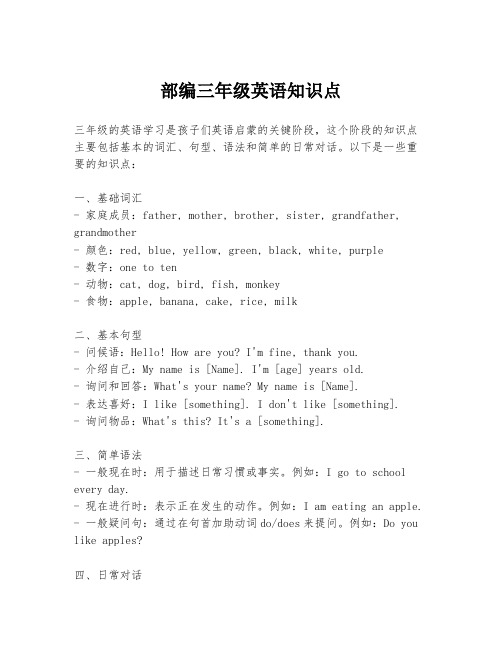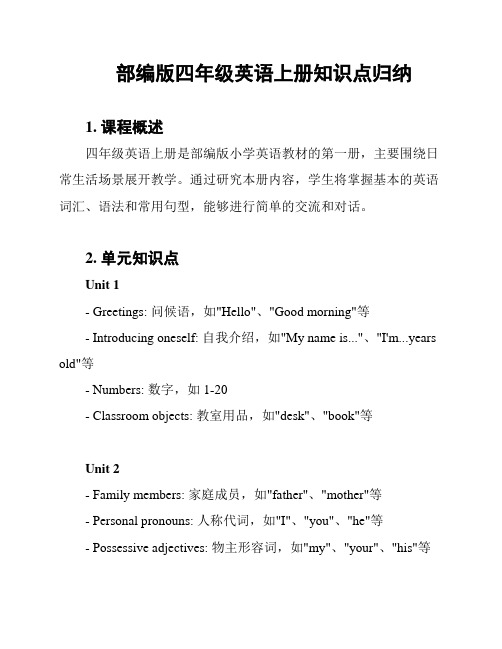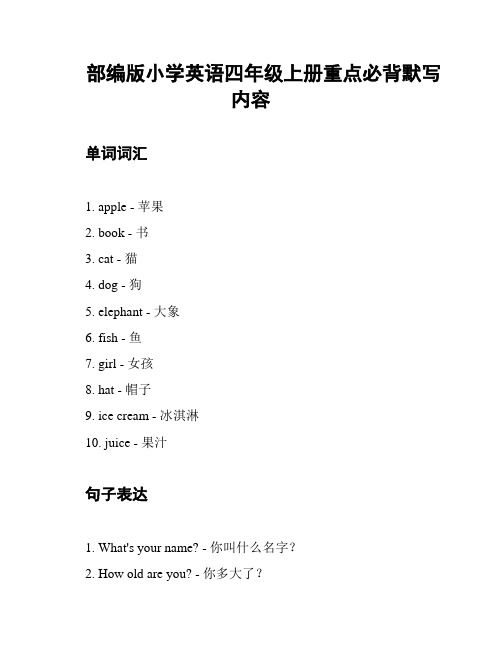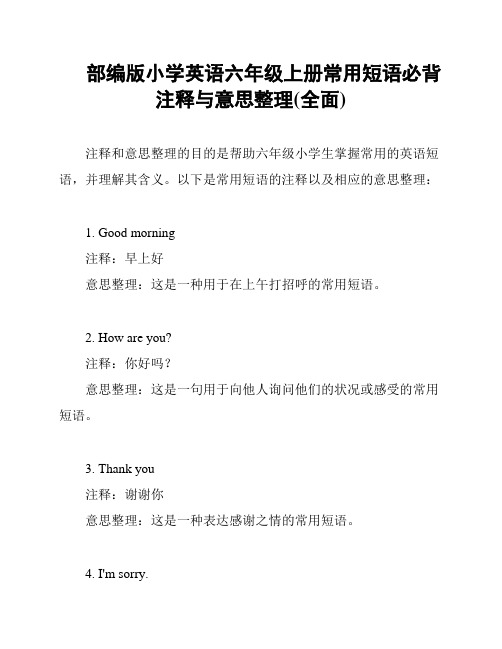人教部编版小学英语知识归纳总结:英语日常用语
人教部编版小学英语知识归纳总结:词汇分类

人教部编版小学英语知识归纳总结:词汇分类一、学习用品pen钢笔pencil铅笔pencil-case铅笔盒ruler尺子eraser橡皮comic book漫画书schoolbag书包crayon蜡笔Chinese book语文书notebook笔记本dictionary词典bag包magazine杂志story-book故事书newspaper报纸sharpener卷post card明信片English book英语书math book数学书book书二、人体foot脚head头face脸hair头发nose鼻子finger手指leg腿tail尾巴mouth 嘴eye眼睛ear耳朵arm手臂hand手三、颜色red红blue蓝yellow黄green绿white白pink粉红purple紫orange 橙brown棕black黑四、动物cat猫dog狗pig猪duck鸭rabbit兔horse马elephant大象fish鱼bird鸟eagle 鹰snake蛇mouse老鼠ant蚂蚁beaver海狸bear熊donkey驴goose鹅deer鹿monkey猴goat山羊squirrel松鼠panda熊猫lion狮子tiger老虎fox狐狸zebra斑马hen母鸡giraffe长颈鹿turkey火鸡lamb小羊sheep绵羊cow奶牛squid鱿鱼lobster龙虾shark鲨鱼seal海豹sperm whale抹香鲸killer whale虎鲸kangaroo袋鼠五、人物friend朋友boy男孩girl女孩mother母亲father父亲sister姐妹brother兄弟man 男人uncle叔叔;舅舅woman女人Mr.先生Miss小姐lady女士;小姐mom 妈妈dad爸爸parents父母son儿子daughter女儿kid小孩baby婴儿grandparents 祖父母grandma/grandmother(外)祖母robot机器人grandpa/grandfather(外)祖父visitor参观者aunt姑姑cousin堂(表)兄弟;堂(表)姐妹classmate同学queen女王neighbour邻居tourist旅行者principal校长people人物university student大学生pen pal笔友六、职业teacher教师student学生doctor医生nurse护士driver司机farmer农民singer歌唱家writer作家actor男演员actress女演员artist画家engineer工程师accountant会计cleaner清洁工salesperson销售员baseball player棒球运动员assistant售货员police警察policeman(男)警察policewoman(女)警察TV reporter电视台记者weather reporter天气预报七、食品、饮料rice米饭bread面包beef牛肉milk牛奶water水egg蛋fish鱼tofu豆腐cake 蛋糕cookie曲奇biscuit饼干jam果酱noodles面条tea茶meat肉chicken鸡肉pork猪肉salad沙拉soup汤Coke可乐mutton羊肉ice冰ice-cream冰淇淋juice果汁coffee咖啡breakfast早餐lunch午餐dinner/supper晚餐meal一餐hot dog热狗hamburger汉堡包French fries炸薯条vegetable蔬菜八、水果、蔬菜apple苹果banana香蕉pear梨orange橙子grape葡萄eggplant茄子green beans青豆tomato西红柿potato土豆peach桃strawberry草莓cucumber黄瓜onion洋葱carrot胡萝卜cabbage卷心菜watermelon西瓜九、衣服jacket夹克衫pants长裤skirt短裙子dress连衣裙socks袜子jeans牛仔裤T-shirt丅恤衫shirt衬衫shoes鞋子sweater毛衣coat上衣raincoat雨衣shorts短裤sneakers网球鞋slippers拖鞋sandals凉鞋boots靴子hat(有沿的)帽子cap便帽cloth 布sunglasses太阳镜tie领带scarf围巾gloves手套trousers裤子clothes 衣服十、交通工具bike自行车bus公共汽车train火车jeep吉普车ship轮船yacht快艇motor cycle摩托车boat小船car小汽车taxi出租车van小货车plane/airplane飞机subway/underground 地铁十一、杂物window窗户door门desk课桌chair椅子computer计算机board写字板fan风扇light 灯teacher’s desk讲台picture图画;照片wall墙壁floor地板curtain窗帘trash bin垃圾箱closet壁橱mirror镜子end table床头柜present礼物walkman随身听lamp台灯sofa沙发football/soccer足球phone电话shelf书架fridge冰箱bed床table桌子TV电视air-conditioner空调key钥匙lock锁photo照片chart图表plate盘子knife 刀fork叉spoon勺子chopsticks筷子pot锅gift礼物toy玩具doll洋娃娃ball 球balloon气球kite风筝jigsaw puzzle拼图游戏box盒子umbrella伞zipper拉链violin小提琴tube管子yo-yo溜溜球nest鸟窝hole洞toothbrush牙刷menu菜单e-card电子卡片money钱e-mail电子邮件traffic light交通灯medicine药十二、地点home家room房间bedroom卧室bathroom卫生间living room起居室kitchen厨房classroom教室school学校park公园library图书馆post office邮局police office警察局hospital医院cinema电影院bookstore书店farm农场zoo动物园garden花园study 书房playground操场canteen食堂teacher’s office教师办公室library图书馆gym体育馆flat公寓washroom卫生间art room绘画教室computer room计算机教室music room音乐教室city城市TV room电视机房company公司factory工厂fruit stand水果摊pet shop 宠物商店nature park自然公园theme park主题公园science museum科学博物馆the Great Wall长城supermarket超市bank银行country国家village乡村hometown家乡bus stop公交车站十三、课程sports体育运动science科学Moral Education 思想品德课Social Studies社会课Chinese语文math数学PE体育课English英语课十四、国家、城市China/PRC中国America/USA美国UK联合王国England英国Canada/CAN加拿大Australia澳大利亚New York纽约London伦敦Sydney悉尼Moscow莫斯科Cairo开罗十五、气象cold寒冷的warm温暖的cool凉爽的snowy下雪的sunny晴朗的hot炎热的rainy下雨的windy有风的cloudy多云的weather report天气预报十六、景物river河流lake湖泊stream河;溪forest森林path小道road公路house 房子rain雨cloud云bridge桥building建筑物sun太阳mountain山sky 天空rainbow彩虹wind风air空气moon月亮十七、植物flower花grass草tree树seed种子sprout苗plant植物rose玫瑰leaf叶子十八、星期Monday星期一Tuesday星期二Wednesday星期三Thursday星期四Friday星期五Saturday星期六Sunday星期天weekend周末十九、患病have a fever发烧hurt疼痛have a cold感冒have a toothache牙疼have a headache 头疼have a sore throat喉咙疼二十、季节spring春summer夏fall/autumn秋winter冬二十一、方位south南north北east东west西left左边right右边二十二、月份Jan. (January)一月Feb.(February)二月Mar.(March)三月April四月May五月June六月July七月Aug.(August)八月Sept.(September)九月Oct.(October)十月Nov.(November)十一月Dec.(December)十二月二十三、数词one一two二three三four四five五six六seven七eight八nine九ten十eleven十一twelve十二thirteen十三fourteen十四fifteen十五sixteen十六seventeen十七eighteen十八nineteen十九twenty二十thirty三十forty四十fifty 五十sixty六十seventy七十eighty八十ninety九十forty-two四十二hundred百one/a hundred and thirty-six一百三十六first第一second第二third第三fourth第四fifth第五eighth第八ninth第九twelfth第十二twentieth第二十thirtieth第三十fortieth第四十fiftieth第五十sixtieth第六十seventieth第七十eightieth第八十ninetieth第九十fifty-sixth第五十六二十四、形容词(adj)big大的small小的long长的tall高的short短的;矮的young年轻的old旧的;老的strong健壮的thin瘦的active积极活跃的quiet安静的nice好看的kind和蔼亲切的strict严格的smart聪明的funny滑稽可笑的tasty好吃的sweet甜的salty咸的sour酸的fresh新鲜的favourite最喜爱的clean干净的tired疲劳的excited兴奋的angry 生气的happy高兴的bored无聊的sad忧愁的taller更高的shorter更矮的stronger 更强壮的older年龄更大的younger更年轻的bigger更大的heavier更重的longer更长的thinner更瘦的smaller更小的good好的fine好的great很好的heavy 重的fat胖的happy快乐的new新的right对的hungry饥饿的cute逗人喜爱的little小的lovely 可爱的beautiful漂亮的colourful色彩鲜艳的pretty漂亮的cheap便宜的expensive昂贵的juicy多汁的tender嫩的healthy健康的ill有病的helpful有帮助的high高的easy简单的proud骄傲的sick有病的better更好的higher更高的二十五、介词(prep)in在……里on在……上;在……时候under在……下面near在……的旁边behind 在……后边next to与……相邻over在……上面in front of在……前面二十六、代词(pron)I我we我们you你;你们he他she她it它they他(她,它)们my我的our 我们的your你的;你们的his他的her她的二十七、动词(v)play(.ed)玩;踢swim(swam)游泳kate滑冰fly(flew)飞jump跳walk走run(ran)跑climb爬fight(fought)打架swing(swung)荡eat(ate)吃sleep(slept)睡觉like像,喜欢turn转弯have(had)有;吃buy(bought)买take(took)买;带live居住teach(taught)教go(went)去study(studied)学习learn学习(learned)sing(sang)唱歌dance跳舞row划do(did)做do homework做作业do housework做家务watch TV看电视read(read) books读书cook the meals做饭water the flowers浇花sweep(swept) the floor扫地clean the bedroom打扫卧室make(made) the bed铺床set(set) the table摆饭桌wash the clothes洗衣服do the dishes洗碗碟use a computer使用计算机go to school上学eat breakfast吃早饭eat dinner吃晚饭do morning exercises晨练;做广播操have English class上英语课play sports进行体育运动get(got)up起床climb mountains爬山go shopping买东西play the piano弹钢琴visit grandparents看望(外)祖父母go hiking去远足fly kites 放风筝make a snowman堆雪人plant trees种树draw(drew) pictures画画cook dinner做饭read a book看书play chess下棋answer the phone接电话listen to music听音乐clean the room打扫房间write(wrote) a letter写信write an e-mail写电子邮件drink(drank) water喝水take pictures照相watch insects观察昆虫pick up leaves 采摘树叶do an experiment做实验catch butterflies捉蝴蝶count insects数昆虫collect insects收集昆虫collect leaves收集树叶write a report写报告have a picnic举行野餐get to到达ride(rode) a bike骑自行车play the violin拉小提琴make kites 制作风筝collect stamps集邮meet(met)见面welcome欢迎thank谢谢love爱work工作drink(drank)喝taste尝smell闻feed(fed)喂养shear剪milk挤奶look看guess猜help帮助pass传递how展示use使用clean打扫open打开close关上put放paint绘画tell(told)告诉kick踢bounce反弹ride(rode)骑stop(stopped)停wait等find(found)寻找到drive(drove)驾驶fold折send(sent)寄wash洗shine照耀become变成feel(felt)感觉到think(thought)思考meet(met)遇见fall(fell)落下leave(left)离开wake(woke) up醒来put on穿上take off脱掉hang up挂起wear(wore)穿go home回家go to bed上床睡觉play computer games玩电脑游戏play chess下棋empty the trash倒垃圾put away the clothes收拾衣服get off下车take a trip去旅行read a magazine阅读杂志go to the cinema去看电影go straight向前直走。
部编三年级英语知识点

部编三年级英语知识点三年级的英语学习是孩子们英语启蒙的关键阶段,这个阶段的知识点主要包括基本的词汇、句型、语法和简单的日常对话。
以下是一些重要的知识点:一、基础词汇- 家庭成员:father, mother, brother, sister, grandfather, grandmother- 颜色:red, blue, yellow, green, black, white, purple- 数字:one to ten- 动物:cat, dog, bird, fish, monkey- 食物:apple, banana, cake, rice, milk二、基本句型- 问候语:Hello! How are you? I'm fine, thank you.- 介绍自己:My name is [Name]. I'm [age] years old.- 询问和回答:What's your name? My name is [Name].- 表达喜好:I like [something]. I don't like [something].- 询问物品:What's this? It's a [something].三、简单语法- 一般现在时:用于描述日常习惯或事实。
例如:I go to school every day.- 现在进行时:表示正在发生的动作。
例如:I am eating an apple. - 一般疑问句:通过在句首加助动词do/does来提问。
例如:Do you like apples?四、日常对话- 购物对话:Can I help you? Yes, I want to buy a [something]. - 学校对话:What class are you in? I'm in Class [Number].- 家庭对话:What's for dinner? We're having [food].五、歌曲和韵律- 学习英语歌曲和韵律有助于孩子们记忆词汇和句型。
部编版四年级英语上册知识点归纳

部编版四年级英语上册知识点归纳1. 课程概述四年级英语上册是部编版小学英语教材的第一册,主要围绕日常生活场景展开教学。
通过研究本册内容,学生将掌握基本的英语词汇、语法和常用句型,能够进行简单的交流和对话。
2. 单元知识点Unit 1- Greetings: 问候语,如"Hello"、"Good morning"等- Introducing oneself: 自我介绍,如"My name is..."、"I'm...years old"等- Numbers: 数字,如1-20- Classroom objects: 教室用品,如"desk"、"book"等Unit 2- Family members: 家庭成员,如"father"、"mother"等- Personal pronouns: 人称代词,如"I"、"you"、"he"等- Possessive adjectives: 物主形容词,如"my"、"your"、"his"等- Questions and answers about family: 有关家庭的问答句,如"What's your father's name?"、"Is this your sister?"等Unit 3- Colors: 颜色,如"red"、"blue"等- Clothes: 衣服,如"shirt"、"hat"等- Describing clothes: 描述衣服,如"It's blue"、"He's wearing ared shirt"等- Shopping: 购物,如"How much is it?"、"I want to buy..."等Unit 4- Animals: 动物,如"cat"、"dog"等- Describing animals: 描述动物,如"It's small"、"It can fly"等- Habitats: 动物栖息地,如"forest"、"ocean"等- Actions of animals: 动物行为,如"run"、"swim"等3. 研究建议- 多听多说:通过多听英语语音和多与他人进行英语口语交流,提高英语听力和口语能力。
人教版四年级英语知识点总结

人教版四年级英语知识点总结一、单词。
1. 动物类。
- cat(猫)、dog(狗)、duck(鸭子)、pig(猪)、bear(熊)、elephant (大象)、monkey(猴子)、bird(鸟)、tiger(老虎)、panda(熊猫)、zoo(动物园)。
- 例如:I like dogs. They are friendly.(我喜欢狗。
它们很友好。
)2. 食物类。
- cake(蛋糕)、bread(面包)、rice(米饭)、fish(鱼)、juice(果汁)、water(水)、milk(牛奶)、egg(鸡蛋)。
- 如:I'm thirsty. I want some juice.(我渴了。
我想要一些果汁。
)3. 文具类。
- book(书)、pen(钢笔)、pencil(铅笔)、ruler(尺子)、eraser(橡皮)、crayon(蜡笔)、pencil - box(铅笔盒)。
- 例如:My pencil - box is blue.(我的铅笔盒是蓝色的。
)4. 颜色类。
- red(红色)、blue(蓝色)、green(绿色)、yellow(黄色)、black(黑色)、white(白色)、orange(橙色)、brown(棕色)。
- 如:I have a red pen.(我有一支红色的钢笔。
)5. 数字类。
- one(一)、two(二)、three(三)、four(四)、five(五)、six (六)、seven(七)、eight(八)、nine(九)、ten(十)。
- 例如:I have three pencils.(我有三支铅笔。
)二、句型。
1. 询问事物。
- What's this?(这是什么?)- What's that?(那是什么?)- 回答:It's a/an + 名词。
例如:What's this? It's a cat.(这是什么?它是一只猫。
部编版小学英语四年级上册重点必背默写内容

部编版小学英语四年级上册重点必背默写内容单词词汇1. apple - 苹果2. book - 书3. cat - 猫4. dog - 狗5. elephant - 大象6. fish - 鱼7. girl - 女孩8. hat - 帽子9. ice cream - 冰淇淋10. juice - 果汁句子表达1. What's your name? - 你叫什么名字?2. How old are you? - 你多大了?3. I like to read books. - 我喜欢读书。
4. Can I have an apple? - 我可以吃一个苹果吗?5. Where is my cat? - 我的猫在哪里?6. The dog is brown. - 这只狗是棕色的。
7. The elephant is big. - 这只大象很大。
8. Do you like to eat fish? - 你喜欢吃鱼吗?9. The girl has a red hat. - 那个女孩有一顶红色的帽子。
10. I want to eat ice cream. - 我想吃冰淇淋。
数字和计算1. one - 一2. two - 二3. three - 三4. four - 四5. five - 五6. six - 六7. seven - 七8. eight - 八9. nine - 九10. ten - 十情景对话1. A: What color do you like? - 你喜欢什么颜色?B: I like pink. - 我喜欢粉色。
A: That's nice. - 那很好。
2. A: Can I have some juice? - 我可以喝点果汁吗?B: Yes, of course. - 当然可以。
3. A: Where is the park? - 公园在哪里?B: Go straight and turn left. - 直走然后左转。
部编版小学英语六年级上册常用短语必背注释与意思整理(全面)

部编版小学英语六年级上册常用短语必背注释与意思整理(全面)注释和意思整理的目的是帮助六年级小学生掌握常用的英语短语,并理解其含义。
以下是常用短语的注释以及相应的意思整理:1. Good morning注释:早上好意思整理:这是一种用于在上午打招呼的常用短语。
2. How are you?注释:你好吗?意思整理:这是一句用于向他人询问他们的状况或感受的常用短语。
3. Thank you注释:谢谢你意思整理:这是一种表达感谢之情的常用短语。
4. I'm sorry.注释:对不起意思整理:这是一种表示愧疚或道歉的常用短语。
5. Can you help me?注释:你能帮我吗?意思整理:这是一种请求他人帮助的常用短语。
6. What's your name?注释:你叫什么名字?意思整理:这是一句用于询问他人姓名的常用短语。
7. I don't understand.注释:我不懂。
意思整理:这是一种表示不理解或不明白的常用短语。
8. Excuse me.注释:打扰一下。
意思整理:这是一种礼貌地请求对方让开或让步的常用短语。
9. Nice to meet you.注释:很高兴见到你。
意思整理:这是一种在初次见面时表达高兴之情的常用短语。
10. How old are you?注释:你多大了?意思整理:这是一句用于询问他人年龄的常用短语。
以上是部编版小学英语六年级上册常用短语必背注释与意思整理的全面内容。
通过学习这些常用短语,小学生能够更好地运用英语进行交流和表达。
部编版五年级英语上册词汇、短语、日积月累(必背内容)
部编版五年级英语上册词汇、短语、日积月累(必背内容)第一单元词汇1. family 家庭2. father 父亲3. mother 母亲4. brother 兄弟5. sister 姐妹6. baby 婴儿7. friend 朋友8. school 学校9. teacher 老师10. student 学生短语1. my family 我的家人2. your family 你的家人3. his family 他的家人4. her family 她的家人5. their family 他们的家人6. happy family 幸福的家庭7. go to school 去学校8. go to work 去工作9. in the school 在学校10. after school 放学后日积月累1. I have a happy family.2. My father is a teacher.3. My mother is a doctor.4. My brother is a policeman.5. My sister is a nurse.第二单元词汇1. color 颜色2. red 红色3. yellow 黄色的4. blue 蓝色的5. green 绿色6. black 黑色7. white 白色8. purple 紫色9. pink 粉红色10. orange 橙色短语1. my favorite color 我最喜欢的颜色2. your favorite color 你最喜欢的颜色3. his favorite color 他最喜欢的颜色4. her favorite color 她最喜欢的颜色5. their favorite color 他们最喜欢的颜色6. colorful world 多彩的世界7. look at the colors 看看这些颜色8. show me your colors 给我展示你的颜色9. in the color 在这个颜色中10. after the color 颜色之后日积月累1. My favorite color is blue.2. I like red and yellow.3. She prefers purple to pink.4. They love colorful world.第三单元词汇1. animal 动物2. cat 猫3. dog 狗4. fish 鱼5. bird 鸟6. elephant 象7. tiger 老虎8. lion 狮子9. bear 熊10. panda 熊猫短语1. my favorite animal 我最喜欢的动物2. your favorite animal 你最喜欢的动物3. his favorite animal 他最喜欢的动物4. her favorite animal 她最喜欢的动物5. their favorite animal 他们最喜欢的动物6. wild animal 野生动物7. domestic animal 宠物8. look at the animals 看看这些动物9. in the animal 在这个动物中10. after the animal 动物之后日积月累1. My favorite animal is a cat.2. I like dogs and fish.3. She prefers elephants to tigers.4. They love lions and bears.第四单元词汇1. fruit 水果2. apple 苹果3. banana 香蕉4. orange 橙子5. grape 葡萄6. watermelon 西瓜7. pear 梨8. peach 桃子9. cherry 樱桃10. melon 瓜短语1. my favorite fruit 我最喜欢的水果2. your favorite fruit 你最喜欢的水果3. his favorite fruit 他最喜欢的水果4. her favorite fruit 她最喜欢的水果5. their favorite fruit 他们最喜欢的水果6. eat fruit 吃水果7. like fruit 喜欢水果8. look at the fruit 看看这些水果9. in the fruit 在这个水果中10. after the fruit 水果之后日积月累1. My favorite fruit is a banana.2. I like apples and oranges.3. She prefers grapes to pears.4. They love watermelons and peaches. 第五单元词汇1. vegetable 蔬菜2. carrot 胡萝卜3. potato 土豆4. bean 豆子5. cabbage 白菜6. cucumber 黄瓜7. pepper 辣椒8. eggplant 茄子9. spinach 菠菜10. tomato 番茄短语1. my favorite vegetable 我最喜欢的蔬菜2. your favorite vegetable 你最喜欢的蔬菜3. his favorite vegetable 他最喜欢的蔬菜4. her favorite vegetable 她最喜欢的蔬菜5. their favorite vegetable 他们最喜欢的蔬菜6. eat vegetable 吃蔬菜7. like vegetable 喜欢蔬菜8. look at the vegetable 看看这些蔬菜9. in the vegetable 在这个蔬菜中10. after the vegetable 蔬菜之后日积月累1. My favorite vegetable is a carrot.2. I like potatoes and beans.3. She prefers cucumbers to peppers.4. They love eggplants and spinach.第六单元词汇1. food 食物2. rice 大米3. bread 面包4.鸡蛋 egg5. meat 肉6. fish 鱼7. milk 牛奶8. water 水9. cake 蛋糕10. ice cream 冰淇淋短语1. my favorite food 我最喜欢吃的食物2. your favorite food 你最喜欢吃的食物3. his favorite food 他最喜欢吃的食物4. her favorite food 她最喜欢吃的食物5. their favorite food 他们最喜欢吃的食物6. have breakfast 吃早餐7. have lunch 吃午餐8. have dinner 吃晚餐9. look at the food 看看这些食物10. in the food 在这个食物中日积月累1. My favorite food is rice.2. I like bread and eggs.3. She prefers meat to fish.4. They love milk and cake.第七单元词汇1. season 季节2. spring 春天3. summer 夏天4. autumn 秋天5. winter 冬天6. sunny 晴朗的7. cloudy 多云的8. rainy 雨的9. windy 有风的10. snowy 雪的短语1. my favorite season 我最喜欢的季节2. your favorite season 你最喜欢的季节3. his favorite season 他最喜欢的季节4. her favorite season 她最喜欢的季节5. their favorite season 他们最喜欢的季节6. in the season 在这个季节中7. look at the season 看看这个季节8. after the season 季节之后日积月累1. My favorite season is spring.2. I like sunny days.3. She prefers cloudy weather.4. They love rainy days.第八单元词汇1. clothes 衣服2. shirt 衬衫3. pants 裤子4. dress 连衣裙5. skirt 裙子6. shoes 鞋子7. hat 帽子8. coat 外套9. socks 袜子10. tie 领带短语1. my favorite clothes 我最喜欢的衣服2. your favorite clothes 你最喜欢的衣服3. his favorite clothes 他最喜欢的衣服4. her favorite clothes 她最喜欢的衣服5. their favorite clothes 他们最喜欢的衣服6. wear clothes 穿衣服7. like clothes 喜欢衣服8. look at the clothes 看看这些衣服9. in the clothes 在这些衣服中10. after the clothes 衣服之后日积月累1. My favorite clothes are a T-shirt and jeans.2. I like pants and dresses.3. She prefers skirts to shorts.4. They love shoes and socks.。
人教版小学英语重要句型归纳
三年级上册1. ---What’s your name ——你的名字是什么?--- My name is Chen Jie. ——我的名字是陈洁。
2. --- This is John, ——这是约翰。
---Nice to meet you. ——见到你很高兴。
3. ---How are you ——你好吗?---I’m fine, thank you. ——我很好。
谢谢。
4. ---Let’s paint. ——让我们一起画画吧。
---Great. ——太好了。
5. ---Look! I have a rabbit. ——看!我有一只兔子。
---Cool. ——真酷!6. ---May I have a look ——我能看一下吗?---Sure. Here you are. ——当然可以,给你。
7. I like hamburgers. ——我喜欢汉堡包。
8. ---Have some French fries. ——吃一些薯条吧。
---Thank you. ——谢谢。
9. ---Can I have some chicken ——我可以吃一些鸡肉吗?--- Sure. Here you are. ——当然可以,给你。
10. ---How old are you ——你几岁了?---I’m 9. ——我9岁。
11. ---How many balloons ——有多少只气球?---4. ——4只。
三年级下册1. ---Where are you from ——你来自哪里?--- I’m from America. ——我来自美国。
2. --- Who’s that woman ——那位女士是谁?---She’s my mother. ——她是我的妈妈。
3. --- Who’s that man ——那位男士是谁?---He’s my father. ——他是我的爸爸。
4. ---How many kites can you see ——你能看见多少只风筝?---I can see 12 ——我能看见12只。
部编版小学四年级英语下册全册知识点总结整理归纳
部编版小学四年级英语下册全册知识点总结整理归纳一、语音知识1. 学习并掌握字母组合 "oo" 在单词中的发音,如:look, book, good 等。
2. 学习并掌握字母组合 "er" 在单词中的发音,如:pen, dog, teacher 等。
二、词汇知识1. 动物类词汇:cat, dog, panda, tiger, elephant, giraffe 等。
2. 颜色类词汇:red, yellow, blue, green, black, white 等。
3. 家庭成员类词汇:father, mother, brother, sister, grandma, grandpa 等。
4. 食物类词汇:apple, banana, orange, cake, ice cream, rice 等。
5. 水果类词汇:apple, banana, orange, grape, watermelon, pineapple 等。
6. 数字类词汇:one, two, three, four, five, six, seven, eight, nine, ten 等。
三、语法知识1. 一般现在时:描述经常性和习惯性动作,如:I often go to school by bus.2. 一般过去时:描述过去发生的动作或状态,如:I visited my grandparents last weekend.3. 一般将来时:描述将来要发生的动作或计划,如:I will go to the zoo tomorrow.四、功能句型1. 询问姓名:What's your name?2. 询问年龄:How old are you?3. 询问颜色:What color is it?4. 询问数量:How many do you have?5. 询问喜好:What do you like?五、情景交际1. 打招呼:Hello, nice to meet you.2. 询问天气:What's the weather like today?3. 询问时间:What time is it?4. 道别:Goodbye, see you tomorrow.六、文化知识1. 了解西方节日:Valentine's Day, Easter 等。
小学英语短语大全汇总人教版
小学英语短语大全汇总人教版一、问候和道别1.Hi! - 嗨!2.Hello! - 你好!3.Good morning! - 早上好!4.Good afternoon! - 下午好!5.Good evening! - 晚上好!6.Good night! - 晚安!7.Bye! - 再见!8.See you later! - 后会有期!9.Take care! - 保重!二、自我介绍1.My name is… - 我叫…2.I am… years old. - 我…岁了。
3.I am from… - 我来自…4.Nice to meet you! - 很高兴认识你!三、问候他人1.How are you? - 你好吗?2.How is it going? - 近来如何?3.How do you do? - 你好吗?4.What’s up? - 有什么新鲜事吗?四、表达喜好和不喜欢1.I like… - 我喜欢…2.I don’t like… - 我不喜欢…3.I love… - 我爱…4.I hate… - 我讨厌…五、请求帮助1.Can you help me? - 你能帮助我吗?2.I need your help. - 我需要你的帮助。
3.Could you please…? - 你能…吗?六、道歉和原谅1.I’m sorry. - 对不起。
2.Excuse me. - 请问。
3.It’s my fault. - 是我的错。
4.That’s okay. - 没关系。
七、时间和日期1.What time is it? - 几点了?2.Today is… - 今天是…3.Yesterday was… - 昨天是…4.Tomorrow will be… - 明天是…八、询问和提供信息1.Who are you? - 你是谁?2.What is your name? - 你叫什么名字?3.Where are you from? - 你来自哪里?4.How old are you? - 你多大了?九、道路和方向1.Where is the…? - …在哪里?2.How can I get to…? - 我怎么去…?十、感谢和道谢1.Thank you! - 谢谢!2.Thanks a lot! - 非常感谢!3.You’re welcome! - 不客气!十一、购物和点餐1.How much is it? - 这个多少钱?2.Can I try it on? - 我可以试试吗?3.Can I have the bill, please? - 请给我账单。
- 1、下载文档前请自行甄别文档内容的完整性,平台不提供额外的编辑、内容补充、找答案等附加服务。
- 2、"仅部分预览"的文档,不可在线预览部分如存在完整性等问题,可反馈申请退款(可完整预览的文档不适用该条件!)。
- 3、如文档侵犯您的权益,请联系客服反馈,我们会尽快为您处理(人工客服工作时间:9:00-18:30)。
人教部编版小学英语知识归纳总结:英语日常用语(一)Greetings 问候语1. Hello! / Hi! 你好!2. Good morning / afternoon / evening! 早晨(下午/晚上)好!3. I'm Kathy King. 我是凯西·金。
4. Are you Peter Smith? 你是彼得·史密斯吗?5. Yes, I am. / No, I'm not. 是,我是。
/ 不,我不是。
6. How are you? 你好吗?7. Fine, thanks. And you? 很好,谢谢,你呢?8. I'm fine, too. 我也很好。
9. How is Amy / your wife / your husband?爱米好吗?/你妻子好吗?/你丈夫好吗?10. She is very well, thank you. 她很好,谢谢。
11. Good night, Jane. 晚安,简。
12. Good-bye, Mike. 再见,迈克。
13. See you tomorrow. 明天见。
14. See you later. 待会儿见。
15. I have to go now. 我必须走了。
(二)Expression In Class 课堂用语16. May I come in? 我能进来吗?17. Come in, please. 请进。
18. Sit down, please. 请坐。
19. It's time for class. 上课时间到了。
20. Open your books and turn to page 20.打开书,翻到第20页。
21. I'll call the roll before class. 课前我要点名。
22. Here! 到!23. Has everybody got a sheet?每个人都拿到材料了吗?24. Any different opinion? 有不同意见吗?25. Are you with me? 你们跟上我讲的了吗?26. Have I made myself clear? 我讲明白了吗?27. Could you say it again? 你能再说一遍吗?28. Any questions? 有什么问题吗?29. That's all for today. 今天就讲到这里。
30. Please turn in your paper before leaving.请在离开前将论文交上。
(三)Identifying Objects 辨别物品31. What's this? 这是什么?32. It's a pen. 是支笔。
33. Is this your handbag? 这是你的手提包吗?34. No, it isn't. / Yes, it is. 不,它不是。
/是的,它是。
35. Whose pen is this? 这是谁的笔?36. It's Kate's. 是凯特的。
37. Is that a car? 那是一辆小汽车吗?38. No, it isn't. It's a bus. 不,那是一辆公共汽车。
39. What do you call this in English?这个用英语怎么说?40. What is the color of your new book?你的新书是什么颜色的?41. How big is your house? 你的房子有多大?42. How long is the street? 这条街有多长?43. What's the name of the cat? 这猫叫什么名字?44. Where's the company? 那个公司在哪儿?45. Which is the right size? 哪个尺码是对的?(四)About Belongings 关于所有物46. What's this? 这是什么?47. It's an air-conditioner. 这是空调。
48. Is this yours? 这是你的吗?49. Yes, it's mine. 是的,是我的。
50. Where are my glasses? 我的眼镜在哪儿?51. Do you know where I've put my glasses?你知道我把眼镜搁哪儿了吗?52. Over there. 在那边。
53. On the desk. 在桌上。
54. Is this your pen? I found it under the desk.这是你的笔吗?我在桌下捡的。
55. No. Mine is blue. 不是。
我的是蓝的。
56. Which is your bag? 哪个是你的包?57. The bigger one. 大些的那个。
58. The one on your right. 你右边的那个。
59. Are these books all yours?这些书全是你的吗?60. Some of them are mine. 一部分是我的。
(五)Identifying People 辨别身份61. Who are you? 你是谁?62. I'm Jim. 我是吉姆。
63. Who is the guy over there? 那边那个人是谁?64. He's Bob. 他是鲍勃。
65. Is that girl a student? 那个女孩是学生吗?66. No, she isn't. 不,她不是。
67. What do you do? 你是做什么的?68. I'm a farmer. 我是个农民。
69. What does he do? 他是干什么的?70. He's a manager. 他是个经理。
71. She must be a model, isn't?她一定是个模特,不是吗?72. I really don't known. 我真不知道。
73. I have no idea about it. 我一点都不知道。
74. Can she be a driver? 她可能是个司机吗?75. Yes, I think so. 是的,我认为是。
(六)About Introduction 关于介绍76. What's your name? 你叫什么名字?77. May I have your name? 能告诉我你的名字吗?78. My name is Thomas. 我叫汤姆斯。
79. Just call me Tom. 就叫我汤姆吧。
80. What's your family name? 你姓什么?81. My family name is Ayneswonth. 我姓安尼思华斯。
82. How do you spell it? 怎么拼?83. Who is the lady in white?穿白衣服的那位小姐是谁?84. Could you introduce me to her?你能把我介绍给她吗?85. Rose, let me introduce my friend to you.罗斯,让我介绍一下我的朋友。
86. This is Tom. He's my classmate.这是汤姆。
我的同学。
87. Nice to meet you. 很高兴认识你。
88. Nice to meet you, too. 认识你我也很高兴。
89. Let me introduce myself. 让我自我介绍一下。
90. How do you do? 你好!(七)Year, Month And Day 年、月、日91. What day is it today? 今天星期几?92. It's Monday today. 今天是星期一。
93. What's the date today? 今天是几号?94. It's January the 15th, 1999. 今天是1999年1月15日。
95. What month is this? 现在是几月?96. It's December. 现在是十二月。
97. What year is this? 今年是哪一年?98. It's the year of 1999. 今年是1999年。
99. What will you do during this weekend?这周末你干什么?100. Does the shop open at 9 am on weekdays?这家店平日是早上9点开门吗?101. It opens at 8 am on weekdays, but at 9 at weekends.平日上午8点开,但周末9点开。
102. What will you do the day after on next?后天你干什么?103. What did you do the week before last?上上星期你干了什么?104. I'll work for the next 5 days.我要工作5天(从明天算起)105. It's been 5 years since I last saw you.我已5年没见你了。
(八)Talking About Objects 谈论事物106. Do you have a computer? 你有计算机吗?107. Yes, I do. 是的,我有。
108. He has that book, doesn't he? 他有那本书,是吗?109. No, he doesn't. 不,他没有。
110. Do you have any brothers or sisters?你有兄弟或姐妹吗?111. No, I'm a single son. 没有,我是独生子。
112. Does your computer have a modem?你的电脑有调制解调器吗?113. Do you have shampoo here? 这儿有香波卖吗?114. What a beautiful garden you have!你的花园真漂亮。
115. Any tickets left? 有剩票吗?。
